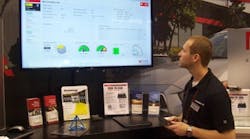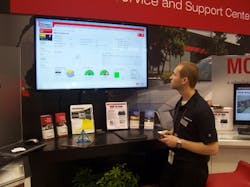Jim Montague is the executive editor for Control. Email him at [email protected].
Even though the Internet supposedly made in-person, face-to-face tradeshows obsolete long ago, I seem to have more events than ever on my schedule. I think I was into my second dozen this past fall alone. Oh well, I just chalk it up as another illogical, counterintuitive outcome that's nonetheless true — like wireless requiring added wires in its transmitting and receiving components, or computers generating more paper instead of less.
Anyway, chief among the common themes at 2014's shows, users groups, conferences and other gatherings were the Internet of Things (IoT), Industry 4.0, intelligent devices, big data, virtualized computing and the cloud. Everything is getting "smart."
Of course, most machines and production lines have long had Ethernet ports for remote monitoring via virtual private networks (VPNs), and they've more recently gained Internet connections and webpages to deliver data and accept orders from the enterprise level. However, it's becoming obvious that these events were just the tip of that well-known iceberg.
For instance, at the recent International Manufacturing Technology Show in Chicago, Mitsubishi's MC Machinery Systems demonstrated its MC Connect software and HMI for detailed monitoring of its laser-cutting systems and electrical discharge machines (EDMs), which use charged wires to help to cut and die-sink small holes and specialized cavities in dies, stampings, keyways and molds. The firm planned to launch MC Connect for its laser machines by the end of 2014 and for its EDMs later this year.
Doug Conroy, MC Machinery's senior customer support engineer, adjusts the MC Connect interface at the Mitsubishi exhibit at IMTS 2014 in Chicago.
(Source: Jim Montague)
"Our machines work in many high-production shops, and they need faster and easier monitoring," says Doug Conroy, MC Machinery's senior customer support engineer. "MC Connect combines data adaptation functions, software, communications and dashboard design and development in one package, which lets users quickly examine all their machines. They can check run, stop, idle and disconnect status, alarms and current job progress, but MC Connect also shows the laser cutter's active parts and feed rates, active materials, program running, run history, laser gas status and previous maintenance cycles. The EDM version monitors its wire insert for breakage and time spent on each program."
To maintain secure communications and avoid using customers' Internet protocol (IP) connections, MC Connect employs an industrial PC (IPC) communication node, which collects machine operating data via file transfer protocol (FTP), secures it with secure sockets layer (SSL) encryption and then uploads to Mitsubishi's cloud server. "The server can process data from more machines and then gives us and our users permission to query the information we need," adds Conroy.
So, despite the cloud's ethereal-sounding name and the detached appearance of virtual computing and IoT, they require the same tight links to physical manufacturing processes, sensors and actual operating data as their predecessors. Just like the software on which it's founded, Industry 4.0 must touch reality and the physical world at some point to do its job, and this means networking.
"A network backbone based on open and secure standards is especially important for smart manufacturing," says Daymon Thompson, TwinCAT specialist at Beckhoff Automation (www.beckhoffautomation.com). "Connectivity is the linchpin, and standards-based components and networks enable users to plug-and-play more PLCs and other devices. For example, OPC-UA allows different devices to talk to each other, and so our CX5020 embedded PC connects to the Internet via TCP/IP, and then uses OPC-UA to send SQL server data to Microsoft's Azure cloud service. Users can then call up their data on a tablet PC with Windows 8.1 and see all their information from the sensors to the shop floor to the cloud. The data is displayed from pages on the Azure server and the SQL Azure database."
Thompson reports that making operations data this available can improve machine designs and performance and can help operators and managers to make better decisions. "Traditional PLCs usually can't report to the cloud securely without going through an HMI or SCADA software," adds Thompson. "Pushing data up via the Intrernet, OPC-UA and the cloud means users no longer have to reach down through the usual systems. This allows users to find production bottlenecks and potential weak-link components faster, and this means better collective enterprise data and more collaborative decisions."





